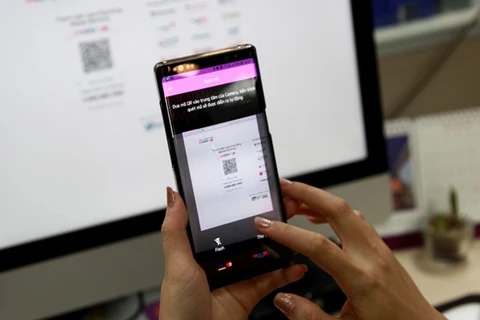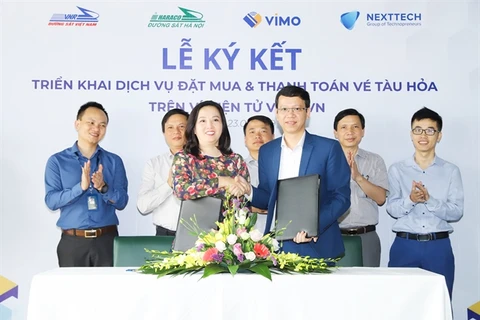Hanoi (VNA) – A change in payment methods is taking place in Vietnam from payment in cash and by cards to a digital and mobile manner. Among a wide range of cashless payment kinds, quick response code (QR) scanning is said to play a significant role in the future payment thanks to its high security and convenience.
The use of QR Code, a bar code made up of black and white squares that can be read by smartphone cameras, point of sale (POS) terminals or other devices, is said to boost cashless payment in Vietnam, an irreversible trend during the era of the fourth Industrial Revolution.
QR code scanning has exploded for years, as multitudes of companies began used them for everything, from advertising and promotions to merchandise tracking and coupons. Consumers are increasingly applying QR codes to access media on the Internet, download offers, and find product information and more.
The codes are then used for payment, with customers scanning a QR code and having money transferred from their account to the merchant, without the need for a POS terminal.
QR code payment has many outstanding advantages as compared to many other forms of mobile payment today. In fact, it is integrated on banking applications, users do not need to download additional applications, while users’ credit or debit cards are linked and they do not have to transfer money back and forth for a payment.
As for Vietnamese customers, they have been increasingly familiar with QR code payments because the service has been offered by large corporations such as Vietnam Airlines, Vietjet Air, Co-opmart, Lotte Mart, petrol retailer PV Oil, as well as a lot of convenience stores, food & beverage and clothes shops.
QR payment benefits customers, merchants, banks
Actually, QR code scanning is a quick and intuitive process for customers, sellers, and banks.
Payment with QR code is more secure fore customers as they are not sharing any details with the merchants. There is a certain amount of risk with POS terminals as card details can be copied using skimming technology.
Besides, it allow the merchants to receive digital payments without the use of POS swiping machine, which means they do not have to pay high cost for POS installation.
As for commercial banks, QR code payment helps them save investment in automated teller machines (ATMs), POS, as well as expansion of payment service.
In Vietnam, 24 banks, including State-owned banks such as Vietinbank, Vietcombank and BIDV, have offered QR code payment services, not to mention other industry players such as fintech and e-wallet firms.
The number of merchants accepting QR code payments increased to 50,000 by mid-2019 from 30,000 at the end of last year.
Scan is for payment - New payment style
It only takes Ms. Nguyet, an office worker in Hanoi, a few seconds for the banking application to scan the VNPAY - QR code and then authenticating with a fingerprint, to finish paying for the recent taxi trip.
“If I used cash or a card before, I will spend a lot of time opening the wallet, paying and waiting for changes, or signing an invoice after using a card… So now using QR Pay is a quick and convenient payment way,” said Nguyet.
Thu Huyen, an interpreter in Hanoi, has chosen QR Pay application for most of her transactions, from utilities payment such as electricity, water, taxi bills to shopping, ordering food, paying for a small cup of coffee.
"For nearly a year now, when I was out of the house, I didn't need to carry a wallet, but just a phone with a banking app installed," Huyen said.
Meanwhile, Ms. Thanh Nga, who works for an international business in Hanoi, shared her thoughts that QR Pay is changing her payment habits as well as millions of other young customers because it is convenient and safe.
Currently, QR Pay is gradually coming to life, popular as a modern and convenient payment style in the fourth industrial lifestyle of part of Vietnamese people - especially young customers, who are living in big city.
With QR Pay (QR Code), customers can easily pay the catering services, shopping, taxi fares, air tickets without bringing cash or bank cards. They just need to process some simple operations such as scanning code, entering information, authenticating on their phone mobile.
Nghia is a final year student of a design school in Ho Chi Minh City. As he often wears minimalist outfit, he doesn’t want to carry a thick wallet with him. By opting for VNPAY-QR, he can perform transactions without the need for cash. When going to coffee, eating out with friends or shopping ... he just needs to use the phone, scan the code and “you're done.” "Just fast and extremely stylish," – Nghia said.
VNPay takes lead in QR code payment trend
Vietnam Payment Solution Joint Stock Company (VNPAY) became the country’s first and only unit integrating payment methods using QR codes on mobile banking applications.
VNPAY was granted a licence by the State Bank of Vietnam for using QR codes in 2011. The QR code payment technology takes advantage of available banking infrastructure and mobile phone utilities to bring a quick, convenient and safe payment method to both sellers and buyers.
Customers could use QR codes on mobile banking apps of different banks to implement payments on e-commerce websites or shops accepting payment by VNPAY-QR.
QR code payment has become a new payment trend in Vietnam for both firms and customers thank to VNPAY’s efforts to expand its markets.
QR Pay has been considered one of solutions for the boom of non-cash payment in Vietnam.
In recent years, the application of e-payment has become an indispensable part of the economy. E-payment helps shorten transaction times, saving management costs for businesses and making the country’s finances more transparent./.

























